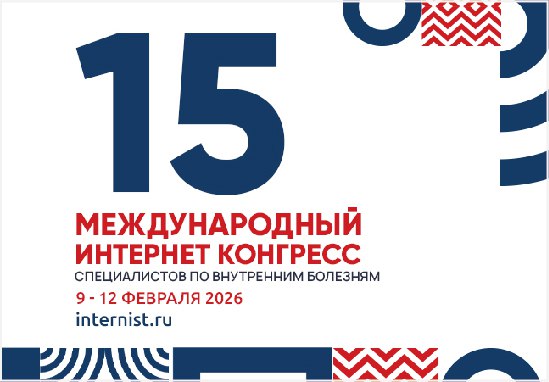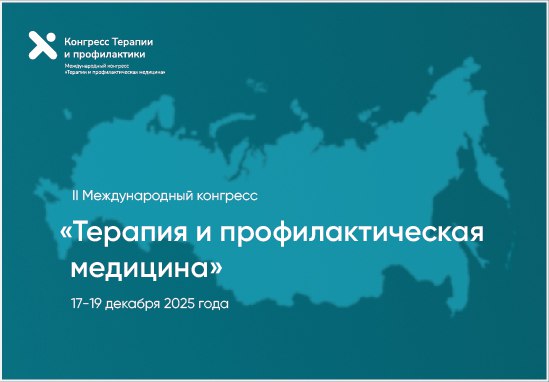Biomarker profile and short-term prognosis of “cardio-reno-metabolic phenotype” in chronic heart failure with preserved ejection fraction
https://doi.org/10.20996/1819-6446-2025-3184
EDN: FGCVZU
Abstract
Aim. To study the biomarker profile, clinical and echocardiographic characteristics of patients with the “cardio-reno-metabolic phenotype” of heart failure with preserved ejection fraction (HFpEF), as well as their impact on the six-month prognosis.
Material and methods. A prospective study of 80 patients with “cardio-reno-metabolic phenotype” of HFpEF was conducted. Anamnesis, clinical and demographic data, concomitant pathology were analyzed, enzyme immunoassay of blood serum was performed to determine the concentrations of the N-terminal fragment of brain natriuretic peptide (NT-proBNP), galectin-3, soluble form of tumor suppressor 2 (sST2), hypoxia-inducible factor 1-alpha (HIF-1α), carboxymethyllysine (CML), a six-minute walk test and echocardiographic examination with assessment of left ventricular diastolic function were performed.
Results. On average, the NT-proBNP level was 125.8 [109.4; 146.9] pg/ml, galectin-3 — 1.2 [0.9; 1.4] ng/ml, sST2 — 1.5 [0.4; 3.8] ng/ml, HIF-1α — 0.13±0.049 ng/ml, CML — 346.69±50.63 pg/ml. Within six months, 36.3% of patients were rehospitalized for any reason, 18.8% of them for cardiovascular diseases. A history of hospitalisation for a cardiovascular cause (decompensated CHF, uncontrolled hypertension, angina, rhythm disturbance) was an important risk factor for rehospitalisation during the six-month observation period. Using ROC analysis and binary logistic regression, clinical, laboratory, and instrumental predictors of early rehospitalisation for cardiovascular causes were identified: a history of such hospitalisation within the previous 6 months, left ventricular enddiastolic dimension greater than 5.05 cm, systolic pulmonary artery pressure greater than 24.5 mm Hg, H2FPEF score greater than 6.5 points, glomerular filtration rate less than 36.97 ml/min/1.73m², Charlson Comorbidity Index greater than 5.5 points, and galectin-3 level less than 1.5 ng/ml . Based on the data obtained, a model for predicting re-hospitalisation during 6 months of observation was developed, the sensitivity of which was 66.7%, specificity — 89.1%.
Conclusion. Predictors of early rehospitalisation for cardiovascular reasons for patients with the “cardio-reno-metabolic phenotype” of HFpEF include the history of hospitalisation for cardiovascular reasons in the previous 6 months, an increase in the left ventricular end-diastolic dimension, elevated systolic pulmonary artery pressure, decreasedglomerular filtration rate, Charlson comorbidity index, galectin-3 level, and the mean H2FPEF score.
About the Authors
O. V. PonomarevaRussian Federation
Olga V. Ponomareva
Ryazan
E. A. Smirnova
Russian Federation
Elena A. Smirnova
Ryazan
A. A. Nikiforov
Russian Federation
Alexander A. Nikiforov
Ryazan
L. V. Nikiforova
Russian Federation
Larisa V. Nikiforova
Ryazan
References
1. Shlyakhto EV, Belenkov YuN, Boytsov SA, et al. Interim analysis of a prospective observational multicenter registry study of patients with chronic heart failure in the Russian Federation “PRIORITET-CHF”: initial characteristics and treatment of the first included patients. Russian Journal of Cardiology. 2023;28(10):5593. (In Russ.) DOI:10.15829/1560-4071-2023-5593.
2. Ndumele CE, Rangaswami J, Chow SL, et al.; American Heart Association. Cardiovascular-Kidney-Metabolic Health: A Presidential Advisory From the American Heart Association. Circulation. 2023;148(20):1606-35. DOI:10.1161/CIR.0000000000001184.
3. Cohen JB, Schrauben SJ, Zhao L, et al. Clinical Phenogroups in Heart Failure With Preserved Ejection Fraction: Detailed Phenotypes, Prognosis, and Response to Spironolactone. JACC Heart Fail. 2020;8(3):172-84. DOI:10.1016/j.jchf.2019.09.009.
4. Gu J, Pan JA, Lin H, et al. Characteristics, prognosis and treatment response in distinct phenogroups of heart failure with preserved ejection fraction. Int J Cardiol. 2021;323:148-54. DOI:10.1016/j.ijcard.2020.08.065.
5. Chen H, Chhor M, Rayner BS, et al. Evaluation of the diagnostic accuracy of current biomarkers in heart failure with preserved ejection fraction: A systematic review and meta-analysis. Arch Cardiovasc Dis. 2021;114(12):793-804. DOI:10.1016/j.acvd.2021.10.007.
6. McCullough PA, Olobatoke A, Vanhecke TE. Galectin-3: a novel blood test for the evaluation and management of patients with heart failure. Rev Cardiovasc Med. 2011;12(4):200-10. DOI:10.3909/ricm0624.
7. Aimo A, Januzzi JL Jr, Bayes-Genis A, et al. Clinical and Prognostic Significance of sST2 in Heart Failure: JACC Review Topic of the Week. J Am Coll Cardiol. 2019;74(17):2193-203. DOI:10.1016/j.jacc.2019.08.1039.
8. Ponomareva OV, Smirnova EA. Modern View on the Role of Myocardial Fibrosis and Its Biochemical Markers in Diagnosis of Chronic Heart Failure. Science of the young (Eruditio Juvenium). 2024;12(2):303-16. (In Russ.) DOI:10.23888/HMJ2024122303-316.
9. Kalinin RE, Suchkov IA, Raitsev SN, et al. Role of Hypoxia-Inducible Factor 1α in Adaptation to Hypoxia in the Pathogenesis of Novel Coronavirus Disease 2019. I.P. Pavlov Russian Medical Biological Herald. 2024;32(1):133-44. (In Russ.) DOI:10.17816/PAVLOVJ165536.
10. Khan MI, Ashfaq F, Alsayegh AA, et al. Advanced glycation end product signaling and metabolic complications: Dietary approach. World J Diabetes. 2023;14(7):995-1012. DOI:10.4239/wjd.v14.i7.995.
11. 2020 Clinical practice guidelines for Chronic heart failure. Russian Journal of Cardiology. 2020;25(11):4083. (In Russ.) DOI:10.15829/1560-4071-2020-4083.
12. Larina VN, Lunev VI, Alekhin MN. Left ventricular global function index: prognostic value in patients with heart failure aged 60 years and older. Cardiovascular Therapy and Prevention. 2020;19(5):2404. (In Russ.) DOI:10.15829/1728-8800-2020-2404.
13. Capone F, Sotomayor-Flores C, Bode D, et al. Cardiac metabolism in HFpEF: from fuel to signalling. Cardiovasc Res. 2023;118(18):3556-75. DOI:10.1093/cvr/cvac166.
14. Galyavich AS, Tereshchenko SN, Uskach TM, et al. Clinical practice guidelines for Chronic heart failure. Russian Journal of Cardiology. 2024;29(11):6162. (In Russ.) DOI:10.15829/1560-4071-2024-6162.
15. Kondo T, Campbell R, Jhund PS, et al. Low Natriuretic Peptide Levels and Outcomes in Patients With Heart Failure and Preserved Ejection Fraction. JACC Heart Fail. 2024;12(8):1442-55. DOI:10.1016/j.jchf.2024.04.027.
16. Clemente G, Soldano JS, Tuttolomondo A. Heart Failure: Is There an Ideal Biomarker? Rev Cardiovasc Med. 2023;24(11):310. DOI:10.31083/j.rcm2411310.
17. Trippel TD, Mende M, Düngen HD, et al. The diagnostic and prognostic value of galectin-3 in patients at risk for heart failure with preserved ejection fraction: results from the DIAST-CHF study. ESC Heart Fail. 2021;8(2):829-41. DOI:10.1002/ehf2.13174.
18. Baccouche BM, Rhodenhiser E. Galectin-3 and HFpEF: Clarifying an Emerging Relationship. Curr Cardiol Rev. 2023;19(5):19-26. DOI:10.2174/1573403X19666230320165821.
19. Snetkova AA, Timofeeva NYu, Zadionchenko VS. Diagnostic value of galectin-3 level in patients with chronic heart failure and type 2 diabetes. Rational Pharmacotherapy in Cardiology. 2015;11(2):139-43. (In Russ.) DOI:10.20996/1819-6446-2015-11-2-139-143.
20. Podzolkov VI, Dragomiretskaya NA, Tolmacheva AV, et al. Prognostic significance of NT-proBNP and sST2 in patients with heart failure with preserved and mildly reduced ejection fraction. Rational Pharmacotherapy in Cardiology. 2023;19(4):310-9. (In Russ.) DOI:10.20996/10.20996/1819-6446-2023-2919.
21. Shi Y, Liu J, Liu C, et al. Diagnostic and prognostic value of serum soluble suppression of tumorigenicity-2 in heart failure with preserved ejection fraction: A systematic review and meta-analysis. Front Cardiovasc Med. 2022;9:937291. DOI:10.3389/fcvm.2022.937291.
22. Hartog JW, Voors AA, Bakker SJ, et al. Advanced glycation end-products (AGEs) and heart failure: pathophysiology and clinical implications. Eur J Heart Fail. 2007;9(12):1146-55. DOI:10.1016/j.ejheart.2007.09.009.
23. Obokata M, Reddy YNV, Borlaug BA. Diastolic Dysfunction and Heart Failure With Preserved Ejection Fraction: Understanding Mechanisms by Using Noninvasive Methods. JACC Cardiovasc Imaging. 2020;13(1 Pt 2):245-57. DOI:10.1016/j.jcmg.2018.12.034
24. Bonacchi G, Rossi VA, Garofalo M, et al. Pathophysiological Link and Treatment Implication of Heart Failure and Preserved Ejection Fraction in Patients with Chronic Kidney Disease. Biomedicines. 2024;12(5):981. DOI:10.3390/biomedicines12050981.
25. Hu J, He Z, Cheng L, et al. A Predictive Model of Early Readmission for Patients with Heart Failure. J Vasc Dis. 2022;1(2):88-96. DOI:10.3390/jvd1020010.
Supplementary files
Review
For citations:
Ponomareva O.V., Smirnova E.A., Nikiforov A.A., Nikiforova L.V. Biomarker profile and short-term prognosis of “cardio-reno-metabolic phenotype” in chronic heart failure with preserved ejection fraction. Rational Pharmacotherapy in Cardiology. 2025;21(4):362-371. (In Russ.) https://doi.org/10.20996/1819-6446-2025-3184. EDN: FGCVZU
















































